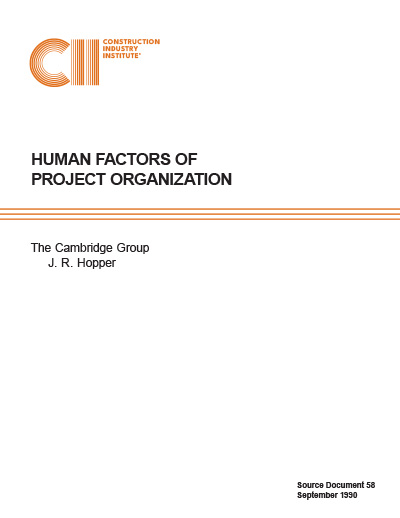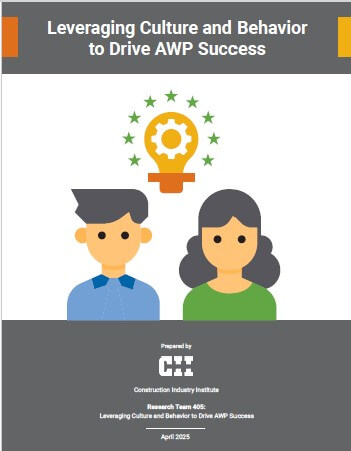
Organizing for Project Success
In studying and evaluating what makes some projects successful, the CII Project Organization Task Force concludes that the following key factors contribute to the success of a project.
First is a recognition by all participants in the project that although the owner is ultimately buying a facility, the process and the people who are responsible for designing, procuring, and constructing the facility also are part of what the client is buying. Recognizing this, the owner must create an atmosphere which fosters a close-knit team working toward a common goal, i.e., completion of a quality facility on time and within budget. The concept of the owner’s buying a process/team aligns well with the CII concept of partnering.
The team, structured hierarchically with the owner providing overall direction, consists of engineering and construction organizations. Because of the high degree of interaction between various organizational entities, successful projects generally involve a complex communications network at all levels within the organization.
One of the most important concepts presented is the uncertainty matrix described in more detail in Chapter 6. The matrix consists of two elements of uncertainty/certainty—what and how. “What” relates to the ultimate definition of the physical facility, and “how” relates to the process of completing the facility from the initial idea through facility completion. In order to complete a project successfully, the total project team must reach agreement relative to the level of project uncertainty at the onset and at various milestones throughout the project. After agreeing, the entire team then is working with a common understanding of the project definition, which enhances the correct major actions and decisions necessary to complete the project.
The task force also studied tools and mechanisms available to project teams to ensure project success. The primary tools during the initial phase of the project are establishing overall project objectives, completing the design basis for the facility, and preparing an execution plan to accomplish the work. Using these tools, the traditional planning, scheduling, and budget tools promoted by CII can be used to monitor and control the efforts of the project team during detailed implementation of the design, procurement, construction, and startup process. These tools provide the mechanism to reduce uncertainty, from both a what and how perspective during the course of the project.
Finally, as important as the above considerations are to the success of a project, the final and most important factor to success is selecting appropriate management and supervisory personnel at all levels of the project organization. These personnel should be leaders, with a strong “close out” drive and an ability to work as integrated members of a team with a common goal.
Developing a project should be viewed as managing a complex decision-making process, rather than merely preparing a series of products. This requires focusing on the commercial contract between parties and the roles of people within work groups. These working groups are teams that work together to accomplish more than they would if they worked separately. The use of teams is central to the construction project approach because a team is where the decision-making process begins.
Research indicates that the “baseball” concept is the traditional approach to teams in the construction industry, but the “football” concept is a better fit for the construction process. Instead of having each party act separately to determine the success of the group, the project should be driven by planning and include diverse relationships throughout the project organization. Key teams include:
- Investment Management Team
- Project Management Team
- Contractor Management Teams
- Work Managers
- Work Manager Teams
Development of a project, from concept to reality, is actually a reduction of the uncertainty process. At every stage of the project, the team is striving to clarify exactly what is to be done and how to do it.
The trend toward early involvement of all concerned parties during construction is beneficial; it assembles the people who know best how to do something with the people who determine what they want. This can be seen in the development of partnering relationships and the recent emphasis on constructability. Difficulty can arise, however, when people who are accustomed to functioning where direction is unambiguous and change is perceived as an enemy, meet people who consider change as beneficial while refining the project plan. Conflict is likely if the owner uses a contract based on a highly certain view of the project, while the contractor views the project definition as unstable.
Refer to SP12-2 for an in-depth description of project uncertainty and success factors.
Many different forms of organizations can be successful; such organizations share a unique set of coordinating tools and mechanisms that allow the group of individuals to act in a cohesive, focused direction toward satisfying a single purpose. Coordinating tools and mechanisms include:
- A comprehensive objective-setting process
- The design basis
- A project strategy
- Work planning
- Information systems
Refer to SP12-2 for an in-depth description of these tools and mechanisms.
The culture of construction projects has unique qualities that form the backdrop, determine the needs and requirements for people to perform, and deliver high performance projects. Several major cultural factors that significantly influence the form and substance of the human organization on projects have been identified. These can be summarized as factors responding to high degrees of risks, often conflicting priorities, goals and rewards, and always uncertainty. The uncertainty factor is a central issue that separates construction requirements from other organizations. A construction project also includes the complex issues associated with several autonomous organizations, each having its own structure and procedures. Human factors must be designed to operate effectively within these variables. Adaptability, resilience, flexibility, guidelines rather than manuals, matrix structures, teams, openness, and leadership are requirements of success.
Refer to SP12-2 for an in-depth description of:
- Project Culture
- Code of Team Conduct
- Key Team Member Selection
- Team Development
SP12-2, Organizing for Project Success
This publication addresses methods, guidelines and considerations necessary for successful project organization, key member roles and selection and effective teamwork. The key theme to successful project organization is the selection of properly skilled people.
This material suggests key tools and mechanisms that include:
- A comprehensive objective-setting process
- The design basis
- A project strategy
- Work planning
- Information systems
- Key team member selection
- Team development



